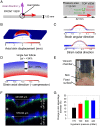Needleless administration of advanced therapies into the skin via the appendages using a hypobaric patch
- PMID: 35482922
- PMCID: PMC9170139
- DOI: 10.1073/pnas.2120340119
Needleless administration of advanced therapies into the skin via the appendages using a hypobaric patch
Abstract
Advanced therapies are commonly administered via injection even when they act within the skin tissue, and this increases the chances of off-target effects. Here we report the use of a skin patch containing a hypobaric chamber that induces skin dome formation to enable needleless delivery of advanced therapies directly into porcine, rat, and mouse skin. Finite element method modeling showed that the hypobaric chamber in the patch opened the skin appendages by 32%, thinned the skin, and compressed the appendage wall epithelia. These changes allowed direct delivery of an H1N1 vaccine antigen and a diclofenac nanotherapeutic into the skin. Fluorescence imaging and infrared mapping of the skin showed needleless delivery via the appendages. The in vivo utility of the patch was demonstrated by a superior immunoglobulin G response to the vaccine antigen in mice compared to intramuscular injection and a 70% reduction in rat paw swelling in vivo over 5 h with diclofenac without skin histology changes.
Keywords: advanced therapeutics; drug delivery; needleless delivery; skin; vaccine.
Conflict of interest statement
The authors declare no competing interest.
Figures





References
-
- Prausnitz M. R., Mitragotri S., Langer R., Current status and future potential of transdermal drug delivery. Nat. Rev. Drug Discov. 3, 115–124 (2004). - PubMed
-
- Hengge U. R., Ruzicka T., Schwartz R. A., Cork M. J., Adverse effects of topical glucocorticosteroids. J. Am. Acad. Dermatol. 54, 1–15, quiz 16–18 (2006). - PubMed
-
- Sheth N. V., McKeough M. B., Spruance S. L., Measurement of the stratum corneum drug reservoir to predict the therapeutic efficacy of topical iododeoxyuridine for herpes simplex virus infection. J. Invest. Dermatol. 89, 598–602 (1987). - PubMed
Publication types
MeSH terms
Substances
LinkOut - more resources
Full Text Sources
Medical

